Drill Cuttings Test of Coal Under Different Stresses and Characteristics of Coal Particle Distribution During Borehole Collapse
Abstract
1. Introduction
2. Test Schemes and Methods
2.1. Coal Specimens Preparation
2.2. Monitoring and Data Analysis Methods
3. Test Results and Analysis
3.1. Drill Cuttings of Intact Coal Specimens with Different Diameters
3.2. Drill Cuttings of Intact Coal Specimens Under Different Stresses
3.3. Drill Cuttings of Fractured Coal Specimens
3.4. Characteristics and Modes of Borehole Collapse
3.5. Particle Size Distribution of Drill Cuttings in Fractured Coal Specimens
4. Discussion
5. Conclusions
- (1)
- When the intact coal specimen is normally drilled, the quantity of drill cuttings increases in proportion to the diameter of the borehole, showing a power function relationship. The quantity of drill cuttings increases in proportion to the coal stress, showing an exponential function relationship.
- (2)
- When the borehole collapse occurs, the coal at the borehole wall pours into the borehole, resulting in a sharp increase in the quantity of drill cuttings. The failure characteristics of the borehole collapse are divided into two forms. One is the cylindrical collapse area, and the other is the conical collapse area.
- (3)
- The distribution and variation law of drill cuttings particle size are positively correlated with coal stress and diameter of the borehole. When there is no collapse, the characteristic value of drill cuttings particle size D50 is in the range of 0.31~0.47, with an average value of 0.39. When there is collapse, the characteristic value of D50 increases to 0.53~0.79, with an average value of 0.66.
Author Contributions
Funding
Data Availability Statement
Conflicts of Interest
References
- Wu, S.K.; Zhang, J.W.; Song, Z.X.; Fan, W.-B.; Zhang, Y.; Dong, X.-K.; Zhang, Y.-J.; Kan, B.-H.; Chen, Z.-S.; Zhang, J.-T.; et al. Review of the development status of rock burst disaster prevention system in China. J. Cent. South Univ. 2023, 30, 3763–3789. [Google Scholar] [CrossRef]
- Xue, C.C.; Cao, A.Y.; Lv, G.W.; Wen, Y.Y.; Liu, Y.Q.; Wang, S.W.; Hao, Q. Study on stress evolution law and rock burst mechanism in upright fold structure area of deep mine. Geomat. Nat. Hazards Risk 2023, 14, 2218013. [Google Scholar] [CrossRef]
- Xu, L.M.; Lu, K.X.; Pan, Y.S.; Qin, Z.J. Study on rock burst characteristics of coal mine roadway in China. Energy Sources Part A Recovery Util. Environ. Eff. 2019, 44, 3016–3035. [Google Scholar] [CrossRef]
- Guo, W.Y.; Zao, T.B.; Tan, Y.L.; Yu, F.-H.; Hu, S.-C.; Yang, F.-Q. Progressive mitigation method of rock bursts under complicated geological conditions. Int. J. Rock Mech. Min. Sci. 2017, 96, 11–22. [Google Scholar] [CrossRef]
- Qiu, P.Q.; Ning, J.G.; Wang, J.; Hu, S.C.; Li, Z. Mitigating rock burst hazard in deep coal mines insight from dredging concentrated stress: A case study. Tunn. Undergr. Space Technol. 2021, 115. [Google Scholar] [CrossRef]
- Zhang, H.; Bai, E.R.; Lu, W.Y.; Ji, X.J.; Sun, Y.; Shao, C.J.; Cao, W.H. Study on the rockburst risk of alternate exterior entry under island coal pillar. Energy Explor. Exploit. 2024. [Google Scholar] [CrossRef]
- Qin, Z.C.; Li, T.; Li, Q.H.; Chen, G.B.; Cao, B. Combined Early Warning Method for Rock Burst and Its Engineering Application. Adv. Civ. Eng. 2019, 2019, 1269537. [Google Scholar] [CrossRef]
- Jiang, B.Y.; Wang, L.G.; Lu, Y.L. Combined early warning method for rockburst in a Deep Island, fully mechanized caving face. Arab. J. Geosci. 2016, 9, 743. [Google Scholar] [CrossRef]
- Du, K.; Bi, R.Y.; Khandelwal, M.; Li, G.C.; Zhou, J. Occurrence mechanism and prevention technology of rockburst, coal bump and mine earthquake in deep mining. Geomech. Geophys. Geo-Energy Geo-Resour. 2024, 10, 98. [Google Scholar] [CrossRef]
- Cao, A.Y.; Dou, L.M.; Cai, W. Tomographic imaging of high seismic activities in underground island longwall face. Arab. J. Geosci. 2016, 9, 232. [Google Scholar] [CrossRef]
- Su, S.J. Optimization of Using Drilling Bits Method to Monitor Rock Burst Hazard Indicators at Water Pre-injection Working Face. Saf. Coal Mine 2013, 44, 174–176. (In Chinese) [Google Scholar] [CrossRef]
- Lv, X.F.; Cao, L.T.; Li, X.Y.; Meng, L.F. Surrounding rock stress distribution characterization via unit cutting energy. Geomech. Geophys. Geo-Energy Geo-Resour. 2022, 8, 184. [Google Scholar] [CrossRef]
- Wang, Z.H.; Tan, J.; Tan, Y.L. Theoretical Study and Experiment Validation on Drilling Cutting Weight during the Whole Process of Drilling. Shock. Vib. 2021, 2021, 4487280. [Google Scholar] [CrossRef]
- Tang, J.P.; Li, W.J.; Pan, Y.S.; Chen, S.; Ding, J.H. Experimental study on the influence of drill pipe diameter and drilling velocity on drilling cuttings. J. Min. Saf. Eng. 2019, 36, 166–174. (In Chinese) [Google Scholar] [CrossRef]
- Geng, Y.F.; Tan, J.; Yin, Y.C.; Tan, Y.L. Theoretical analysis of drilling cuttings considering stress zoning of surrounding rock and its application in stress detection. Energy Sci. Eng. 2023, 11, 1662–1670. [Google Scholar] [CrossRef]
- Tang, J.P.; Chen, S.; Li, W.J. Theoretical and experimental studies on drilling cutting weight considering effective stress. Chin. J. Geotech. Eng. 2018, 40, 130–138. (In Chinese) [Google Scholar] [CrossRef]
- Zhu, G.A.; Han, J.P. Experimental research into the drilling cutting method of rockburst-prone coal under water-rich conditions. Geophys. Geo-Energy Geo-Resour. 2023, 9, 167. [Google Scholar] [CrossRef]
- Zheng, Y.H.; Zhao, Z.G.; Zhao, T.B.; Ma, C.F.; Zhang, K.; Qi, Y.S. A new method for monitoring coal stress while drilling process: Theoretical and experimental study. Energy Sources Part A Recovery Util. Environ. Eff. 2023, 45, 3980–3993. [Google Scholar] [CrossRef]
- Zhu, G.A.; Liu, H.; Su, X.H.; Wang, H.S.; Xu, Z.H.; Liu, H.Y.; Jiang, Q.P. Experimental research on burst-prone coal mass of drilling method under rich water condition. J. China Coal Soc. 2023, 48, 4433–4442. (In Chinese) [Google Scholar] [CrossRef]
- Zhao, Z.G.; Zhang, K.; Yin, Y.C.; Qi, Y.S. Drilling test and drilling energy response of coal under different stresses. Rock Soil Mech. 2023, 44, 2899–2906. (In Chinese) [Google Scholar] [CrossRef]
- Geng, J.S.; Cao, L.W.; Zhong, C.Y.; Wang, H.; Chen, B.Q. Investigation of dynamic response of drilling parameters and deformation characteristics of coal around borehole during multi-stage reaming in tectonic coal. Int. J. Rock Mech. Min. Sci. 2023, 170, 105540. [Google Scholar] [CrossRef]
- Jin, D.Z.; Xin, K.; Yin, L.; Mohammadi, S.; Cetin, B.; You, Z. Performance of rubber modified asphalt mixture with tire-derived aggregate subgrade, Construction and Building Materials. Constr. Build. Mater. 2024, 449, 138261. [Google Scholar] [CrossRef]
- Zhang, T.J.; Liu, N.; Pang, M.K.; Zhang, X.F.; Guo, Y.; Zhang, S. Re-crushing characteristics in the compaction process of graded crushed coal rock mass. J. Min. Saf. Eng. 2021, 38, 380–387. (In Chinese) [Google Scholar] [CrossRef]
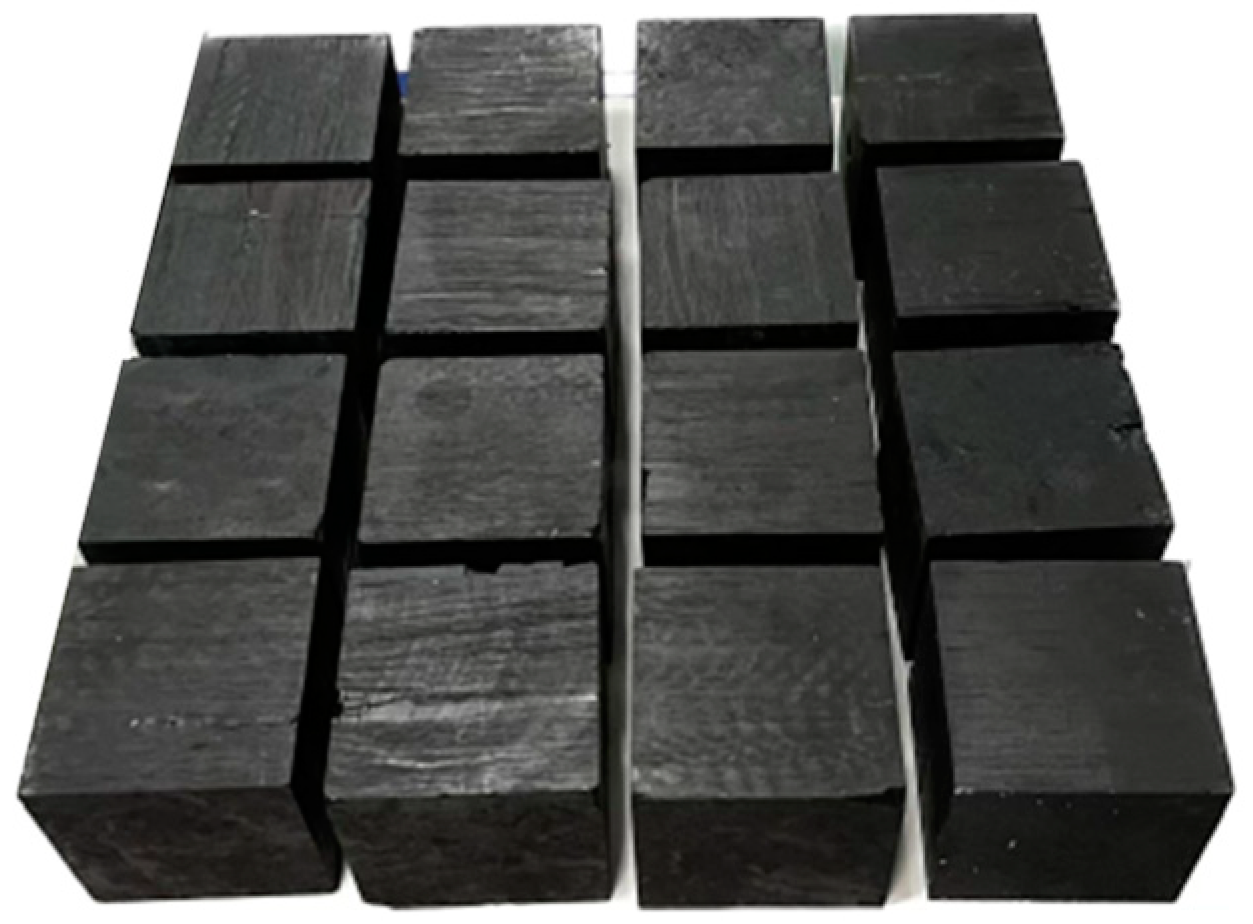

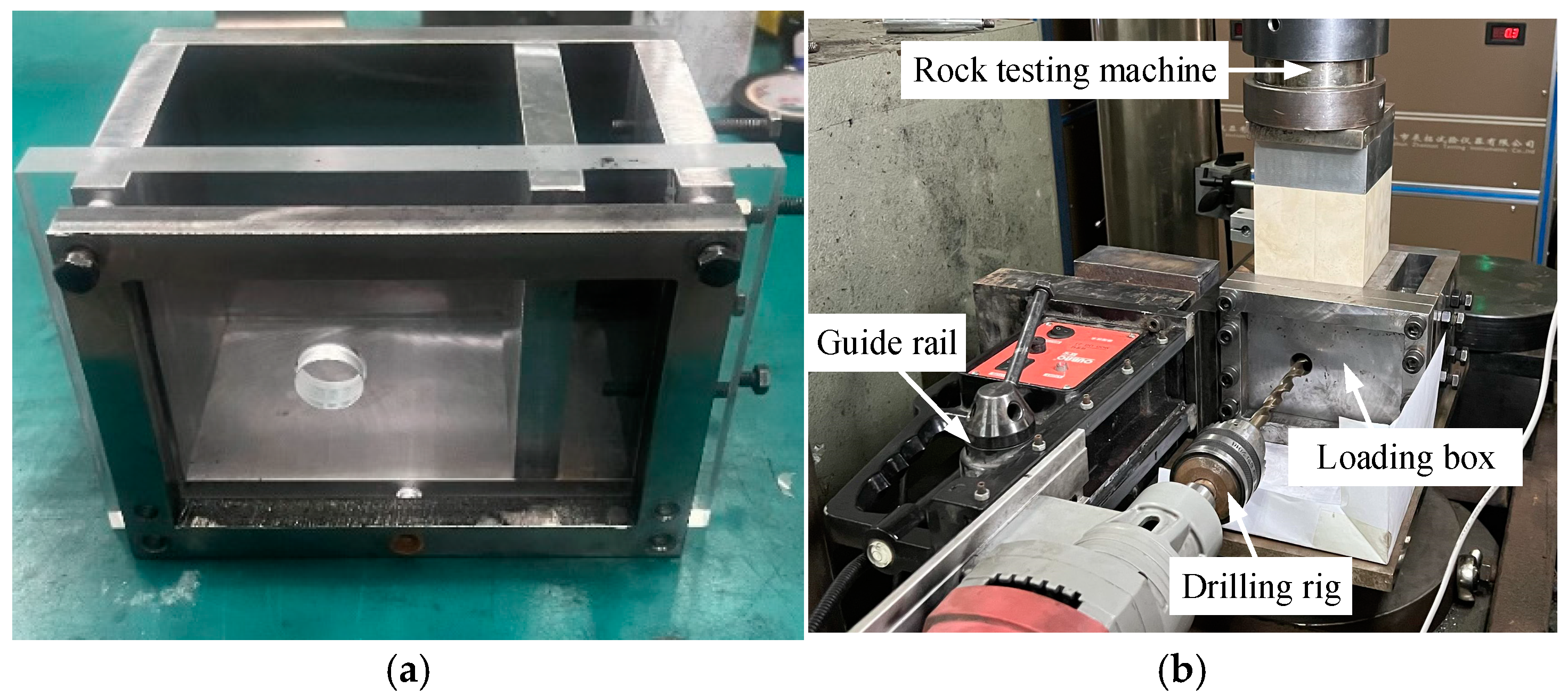

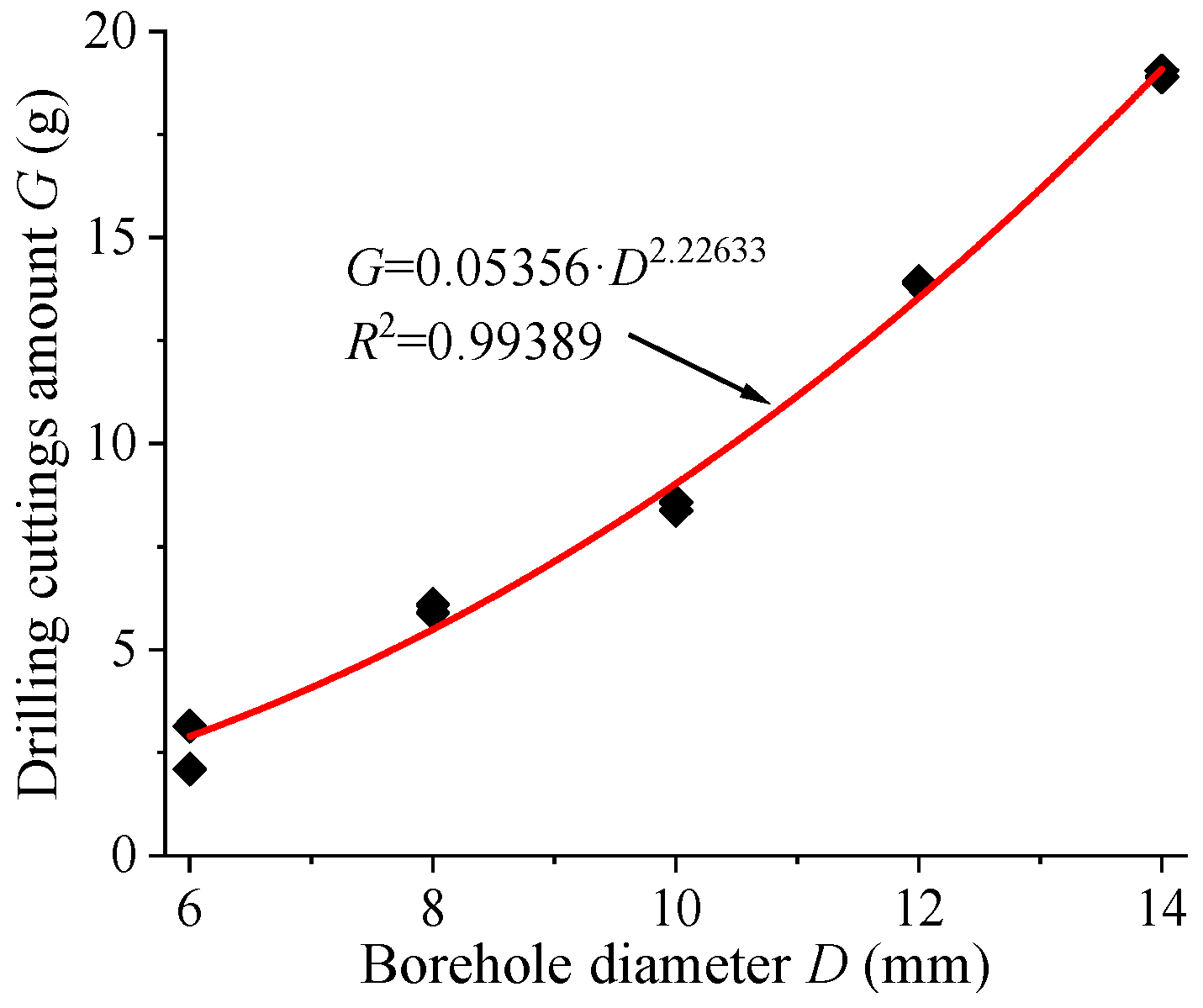
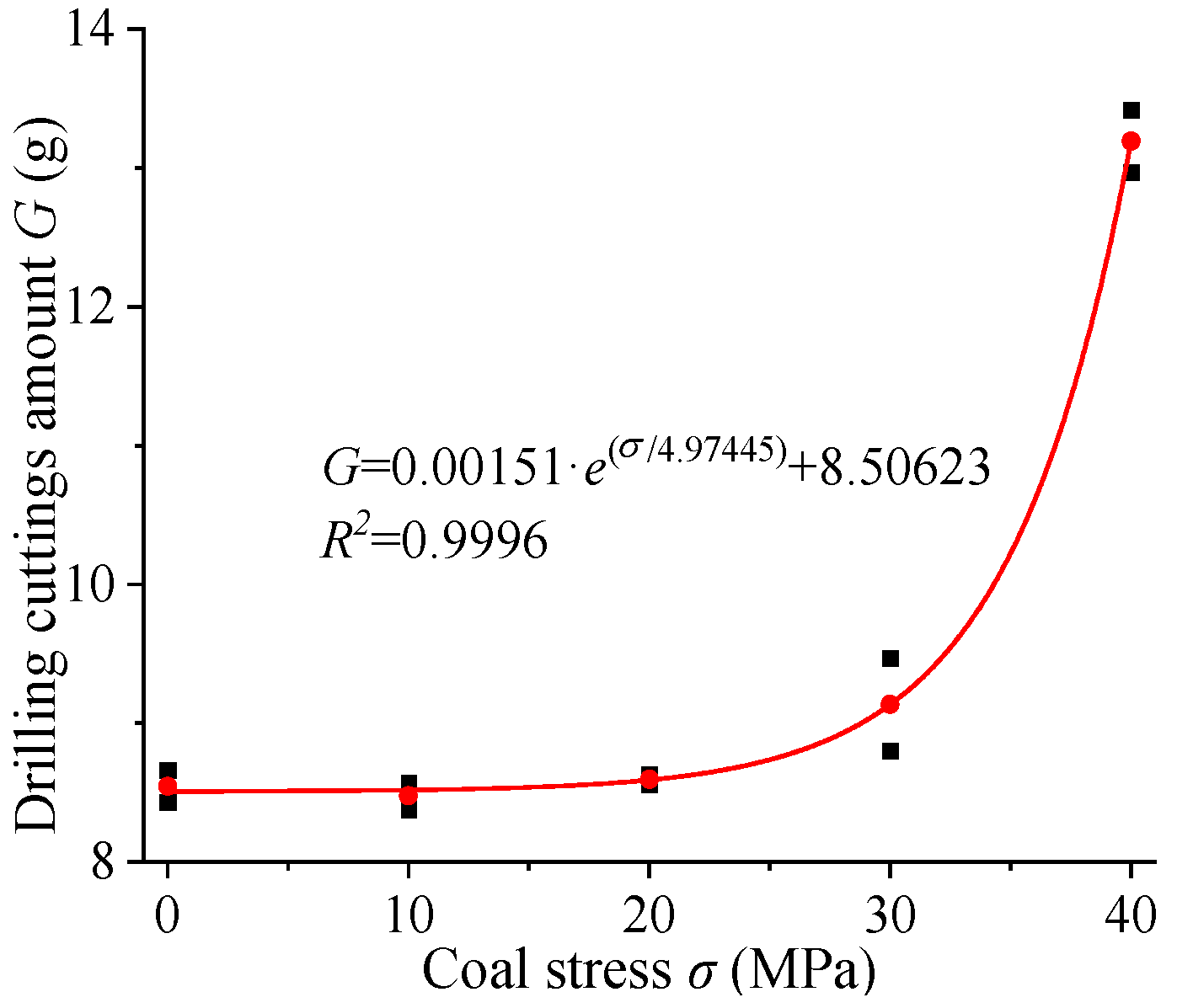



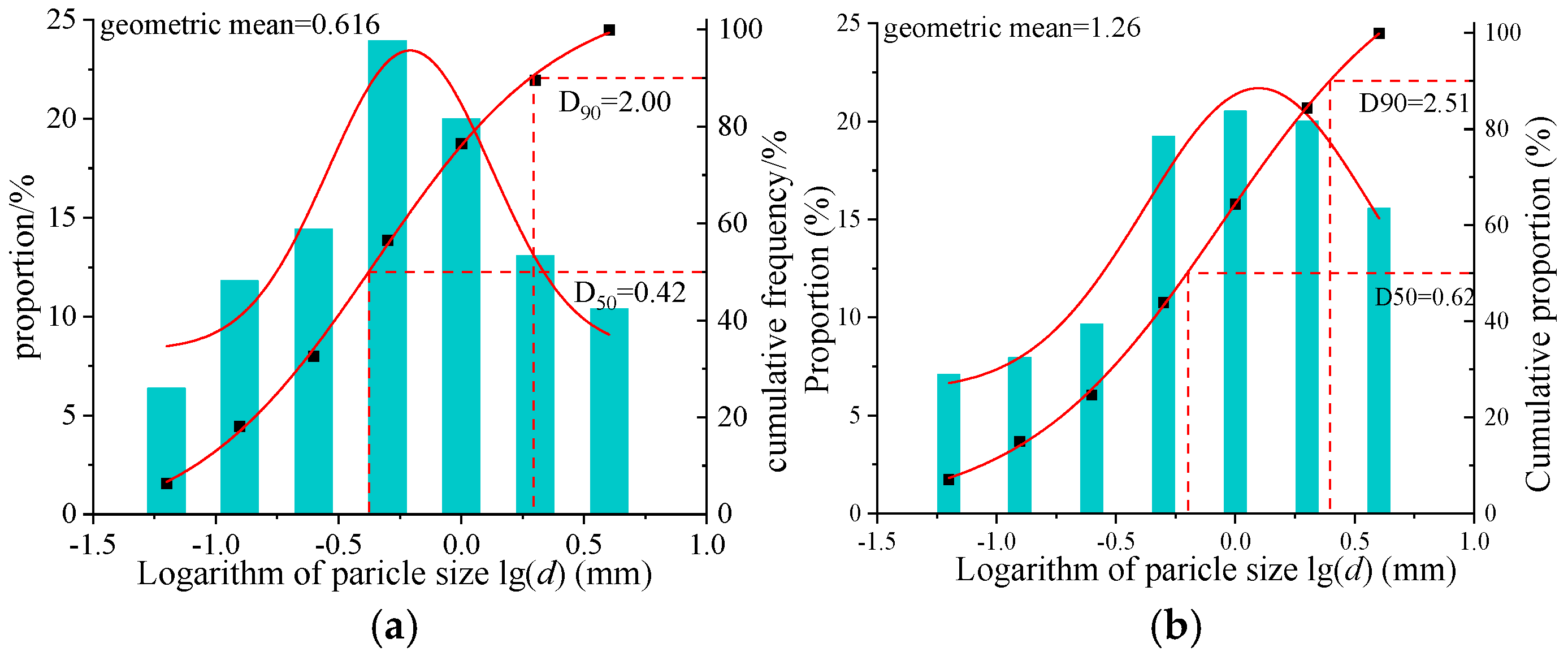

| Coal Particle Size (mm) | 2.5~5 | 5~10 | 10~15 | 15~20 |
|---|---|---|---|---|
| Proportion of mass | 27.5% | 26.5% | 24% | 22% |
| Mass (g) | 302.5 | 291.5 | 264 | 242 |
| Stress (MPa) | Diameter of the Borehole (mm) | Drill Cuttings Amount (g) | ||
|---|---|---|---|---|
| Specimen ① | Specimen ② | Mean Value | ||
| 10 | 6 | 2.1 | 3.14 | 2.62 |
| 10 | 8 | 6.09 | 5.9 | 5.995 |
| 10 | 10 | 8.57 | 8.38 | 8.475 |
| 10 | 12 | 13.92 | 13.88 | 13.9 |
| 10 | 14 | 18.89 | 19.05 | 18.97 |
| Stress (MPa) | Diameter of the Borehole (mm) | Drill Cuttings Amount (g) | ||
|---|---|---|---|---|
| Specimen ① | Specimen ② | Mean Value | ||
| 10 | 10 | 8.57 | 8.38 | 8.475 |
| 20 | 10 | 8.56 | 8.63 | 8.595 |
| 30 | 10 | 8.8 | 9.47 | 9.135 |
| 40 | 10 | 13.42 | 12.97 | 13.195 |
| Stress (MPa) | Drill Cuttings Amount (g) | ||||
|---|---|---|---|---|---|
| D = 6 mm | D = 8 mm | D = 10 mm | D = 12 mm | D = 14 mm | |
| 10 | 4.33 | 9.73 | 12.98 | 18.74 | 26.49 |
| 20 | 6.38 | 10.72 | 14.91 | 22.67 | 78.85 (Collapse) |
| 30 | 6.68 | 18.02 | 167.05 (Collapse) | 102.6 (Collapse) | 77.57 (Collapse) |
| 40 | 14.46 | 125.39 (Collapse) | 63.61 (Collapse) | 100.52 (Collapse) | 85.1 (Collapse) |
Disclaimer/Publisher’s Note: The statements, opinions and data contained in all publications are solely those of the individual author(s) and contributor(s) and not of MDPI and/or the editor(s). MDPI and/or the editor(s) disclaim responsibility for any injury to people or property resulting from any ideas, methods, instructions or products referred to in the content. |
© 2025 by the authors. Licensee MDPI, Basel, Switzerland. This article is an open access article distributed under the terms and conditions of the Creative Commons Attribution (CC BY) license (https://creativecommons.org/licenses/by/4.0/).
Share and Cite
Yin, Y.; Zhang, Q.; Guo, L.; Wang, C.; He, S.; Zhang, D. Drill Cuttings Test of Coal Under Different Stresses and Characteristics of Coal Particle Distribution During Borehole Collapse. Processes 2025, 13, 499. https://doi.org/10.3390/pr13020499
Yin Y, Zhang Q, Guo L, Wang C, He S, Zhang D. Drill Cuttings Test of Coal Under Different Stresses and Characteristics of Coal Particle Distribution During Borehole Collapse. Processes. 2025; 13(2):499. https://doi.org/10.3390/pr13020499
Chicago/Turabian StyleYin, Yanchun, Qingzhi Zhang, Lei Guo, Cunwen Wang, Shudong He, and Dongdong Zhang. 2025. "Drill Cuttings Test of Coal Under Different Stresses and Characteristics of Coal Particle Distribution During Borehole Collapse" Processes 13, no. 2: 499. https://doi.org/10.3390/pr13020499
APA StyleYin, Y., Zhang, Q., Guo, L., Wang, C., He, S., & Zhang, D. (2025). Drill Cuttings Test of Coal Under Different Stresses and Characteristics of Coal Particle Distribution During Borehole Collapse. Processes, 13(2), 499. https://doi.org/10.3390/pr13020499






